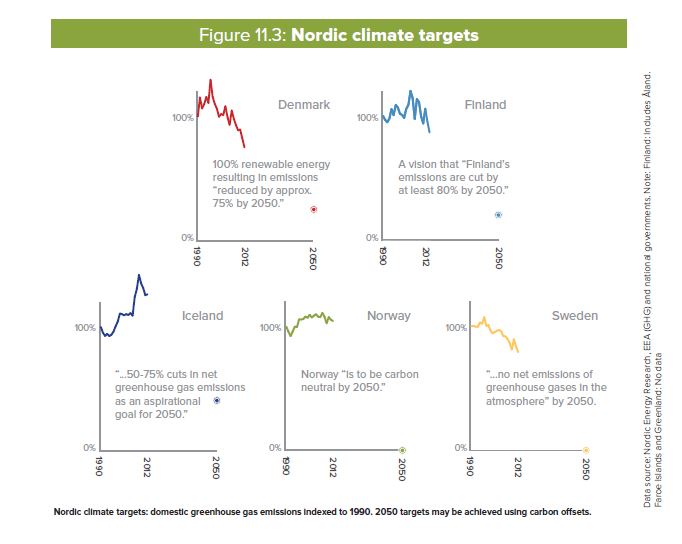The way we live and travel is at the heart of the future energy revolution. As such, this edition of State of the Nordic Region includes chapters on housing and air accessability as a compliment to the energy chapter. The Nordic Region is a global leader in combining ambitious climate and energy policy with steady economic growth. This position is largely the result of an abundance of hydro, nuclear and geothermal energy sources and ambitious, long-term and stable policy frameworks focused on decoupling GDP from CO2. Although this is of course positive, it is important to acknowledge that the majority of these gains have been absorbed by an increase in the absolute demand for energy, particularly in the buildings and transport sectors. As a result, continued action that takes a multipronged approach to energy challenges is required. While renewing our energy consumption we need to bear in mind that providing appropriate and accessible infrastructure is also vital to supporting strong economic growth.
Property has been steadily increasing in value over the past 10 years with increases in all of the Nordic countries surpassing the EU average by a substantial margin. These increases are perhaps a reflection of the failure of new construction rates to keep up with demand, particularly in the larger Nordic cities. Nordic countries have different supplement systems for housing provision, but, as yet, none have managed to address the increasing problem of housing shortage and high property prices in Nordic cities. Air travel is also increasing in all of the Nordic countries. One explanation for this growth is the way that some airports in the Nordic Region have used their peripheral location in a European context as a strategic advantage and become a gateway to other continents. Rail links between airports and city centres have also improved the accessibility of air transport in Copenhagen, Stockholm, Oslo and Helsinki. Substantial opportunity to continue this growth is apparent in the vast majority of airports in the Nordic Region. This has important implications for economic development in both the major cities and more remote regions, but also for the environment.
Chapter 11
THE FUTURE OF NORDIC CLIMATE AND ENERGY (in collaboration with Nordic Energy Research)
The need for energy management is clear. It sets the basic conditions across the globe for societal well-being and defines the parameters for economic growth. This, combined with global attention on climate change in the wake of COP21 and the continuing challenge of maintaining energy security, has placed energy at the forefront of the global political agenda. The Nordic Region has emerged as a global leader in combining ambitious climate and energy policy with steady economic growth. Despite this, room for improvement remains, particularly with respect to the transport and building sectors and in terms of the potential benefits of further Nordic cooperation. This chapter begins by outlining both the current position and the path that is already laid out for us as regards our energy and climate goals. An overview is then provided of a select number of dimensions with respect to the energy sector viewed from a Nordic spatial perspective, including energy production and consumption, with a focus on low-carbon energy. We conclude by exploring the Nordic electricity trade, as well as a number of future developments set to deliver us towards a low carbon energy future.

Read the chapter 11
Chapter 12
HOUSING: Demand exceeds supply in Nordic markets
How we choose to build our cities and regions forms the basis for our everyday lives. The built environment is also an important factor in future social, ecological, economic and spatial development. The character of this future development is however dependent upon the types of housing that are available, what is being built and at what price. Can migrants from other cities, regions or countries afford to move into the area assuming there are homes available to buy or rent? Is affordable student housing available? Answers to questions such as these, and the comparative Nordic approach can, for example, function as indications of social sustainability and integration, i.e. where can people with different resources actually settle and stay in the Nordic countries? Nordic cities are segregated and housing and construction are key factors in this development, influencing the spatial relations between different socio-economic groups.
Read the chapter 12
Chapter 13
AIR ACCESSIBILITY: Passenger numbers increasing, but the best is yet to come
In 2014, nine airports located in Europe were included in the top 50 busiest airports in the world in terms of total number of passengers: none were located in the Nordic Region. Air traffic in Europe is largely dominated by five countries (France, Germany, Italy, Spain and the United Kingdom) which together absorb more than 60% of the total number of passengers. The Nordic Region’s peripheral location and, in a broader European context, relatively low densities of both people and cities, result in a relatively low number of air passenger journeys being undertaken. In 2014, the share of air passengers in the Nordic Region was 13.7% of all passengers in European airports (12.2% in 2008). Looking at the European scale, Copenhagen-Kastrup is
15th, Oslo-Gardermoen is 17th, Stockholm-Arlanda is 21st and Helsinki-Vantaa is 30th.
Read the chapter 13